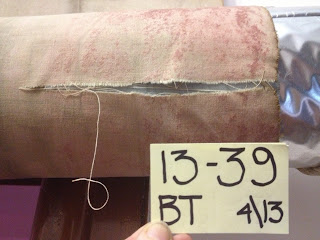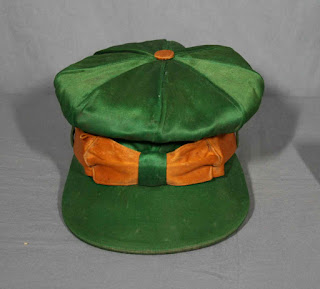by Gwen Spicer
While it may seem like just yesterday, much time has gone by.
Don't we often find ourselves saying this? Think of when you see the child of a friend and you are shocked at how much they've grown. But for the parents of that child, the change was so subtle and so gradual that it was almost invisible.
My thoughts turn to artifacts in collections and how gradually they can change, whether it be damage from light, humidity, temperature, improper storage, etc. I particularly think of artifacts that you may have had the opportunity to examine only to see the item again in 10, maybe 20, years and the change is profound. I cannot help but wonder what caused the change that was invisible day to day but from "then" until "now" is stunning.
 |
| The first time I examined and treated this artifact, there were several tears and structural problems all near the lower section of the curtain. Over the years this tear developed. |
 |
| A detail of a powder horn from 1760 in great condition. The intricate images are clear and the horn is 100% intact. |
Here is a little background: The object is not handled regularly, it is not exposed to light, and it is housed properly. This information tells us that the object is currently cared for properly, but what about prior to this time? Is it being affected by something it was exposed to 50 years ago? Is it sulfur dioxide in the air? Or is it just a natural progress for an organic item of this type?
The radical change to an object can also be predictable. I recently treated a Theater curtain that had been used in a theater in a very small town. The theater is also the hall where town meetings occur, and it serves as a space for community events and gatherings. The space is not heated in winter, nor cooled in summer. When I first saw the backdrop about 4 years ago, it was not in terrible shape, but it clearly needed treatment before the rips and tears became more damaging. When the item was finally approved for treatment, the change that had occurred over four short years was substantial.
When I compare these artifacts for what they have in common, I begin to get a clearer picture. Perhaps what is wrong is that I am stuck on the "why" of the degradation. What I should be paying attention to is that objects of different composition change differently over time, and sometimes the change can be put into high gear despite our best efforts and knowledge. So perhaps the important thing is not to let time slip by.
Think of kids again. Each school year they are photographed, and if you put 1st grade next to kindergarten, the change is not terribly shocking. But put 1st grade next to 8th grade and you may be hard pressed to identify the subject as the same person.
So perhaps certain objects should be photographed more often, maybe once a year is a good time for certain things, like furnishings. But maybe items made of shell, bone or horn need to be photographed every 6 months? Perhaps artifacts are only photographed once each decade until they are 50 years old, then photographed more frequently as they age? My guess is that no single formula will fit all items.
Volumes have been written on the subject, and the view of changes and how they should be described or recorded is subjective based on who you are: conservator, scientist, curator. I recently reread a few sections of "Risk Assessment for Object Conservation" by Jonathan Ashley-Smith. The amount of information available to determine what is (or could be) causing damage is almost too much to comprehend, but each possible contributing aggravator has the potential to produce a negative change, whether it be radical or slow and subtle.
The bottom line: Things change. Change is undeniable and unavoidable. This is not what we want to hear as conservators, curators, or custodians of objects that we are trying desperately to maintain. So my question is; while we are busy constantly trying to avoid changes that will cause degradation of artifacts, are we missing the things that are happening invisibly under our noses?
Gwen Spicer is a textile conservator in private practice. Spicer Art Conservation specializes in textile conservation, object conservation, and the conservation of works on paper. Gwen's innovative treatment and mounting of flags and textiles is unrivaled. To contact her, please visit her website.



+Harness+BT+3.jpg)

No comments:
Post a Comment